Broiler Chickens

Production and welfare
- Broiler breeders are slaughtered around 10 months old once their peak egg production is passed.
- Broiler chickens reared for their meat are killed at about six weeks old.
- Surplus chicks, known as ‘hatchery waste’, are killed by a number of permitted methods.
- Intensively reared broilers live on concrete floored sheds covered with a layer of litter and have little space to move around.
- Selective breeding results in faster growth rates but cripples and deforms the birds as they cannot support their own weight.
Disease
The unnatural growth rate of broilers, together with the lack of space to move around, encourages the birds to rest on the litter (absorbent material scattered on the floor) for long periods of time. This degrades the quality of the litter and in turn the broilers health and welfare, resulting in conditions such as hock burn, breast blisters, skeletal disorders, lameness, bacterial infections and heart-failure.
Transport and slaughter
The process of catching, loading, transporting and unloading broilers can cause serious distress, injury and even death to a significant number of broilers. Long distance transport to slaughter can be common practice and the birds may suffer from extremes of temperature, stress, suffocation and shock.
At the slaughterhouse broilers are shackled upside down while still conscious, before their head and neck are dragged through an electrically charged water bath. This makes them unconscious and their necks are cut.
/
